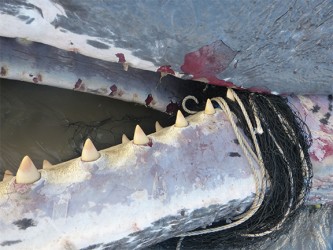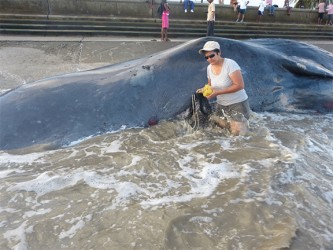Whales are not at home in shallow water. Their territory is the deep, 200 feet or more. The one that showed up this week off Mahaicony, in water 70 feet deep (shallow for a whale) ended up there from becoming entangled in a fisherman’s net. Unless it was freed, the mammal would die. So when the word went out one Saturday evening that a whale was in distress, the volunteers who set out to help knew that, with night intervening, time was against them.
The fisherman who raised the initial alarm was Vridglall Ramesh ‘Gold Teeth’ Tiwari from Mahaicony. A fisherman for 40 years, working the ocean looking for snapper and gilbacker, he had found the whale, midday on Saturday, four miles off the East Coast, trapped in one of his nets. In his 45-foot boat, Miss Nalinee (named after his wife), Ramesh was endeavouring to move the whale closer to shore to get help in untangling the nets. “It was hard, though,” he said. “Yuh cyan get too close, because de whale so powerful; one lash from him would bruk up mi whole boat.” Indeed, even in the 75 feet of water where this was going on, the gyrations from the whale were so powerful they were stirring up mud from the bottom. Ramesh had his engine going full blast (he used up a drum of gasoline in the effort) pulling on a heavy rope attached to the seine. But as they got into shallower water, the whale began to fight, and the force of the pull caused a break in the bow of the fishing boat. “If I had kept on, he woulda sink de boat,” said Ramesh, “so we cut the seine, went ashore, and phoned for help.”
The news reached Annette Arjoon-Martins of the National Wildlife Management Committee early Sunday morning, and she headed out to Mahaicony with Romeo deFreitas, the Turtle Warden from Shell Beach, who was in town that day. “Along with Sophie Edgehill from World Wildlife Fund, we went to liaise with Ramesh. I had also called Commander Flores from the GDF; he arranged the Army helicopter, and Air Services Limited donated the fuel for the aerial search. Through Dr Raquel Thomas and Vanessa Benn we had been in contact with the Caribbean whaling network and they had suggested we photograph the animal and email it to them for their advice, so we did a helicopter search that afternoon, with an NCN cameraman aboard, but we ran out of daylight without finding the whale.”
On Monday morning, on a Coast Guard patrol boat provided by Commander Burnett, the group was out at 7am looking to find the whale alive. “After 6 hours in very rough seas – my bones ached for three days afterward – we had found nothing. It was a huge disappointment. And then, on Tuesday morning at 5am, Dennis Chabrol of Demerara Waves called to say the whale had washed up at Kitty foreshore. When we got there, the whale was still warm with the fishing net wrapped around his mouth, but blood was coming out of the blowhole; it was clearly dead and would have to be moved as it was close to a heavily populated area. It was such a sad moment; it almost brought you to tears.” By this time, word had spread about the beaching, and thousands had gathered on the seawall to watch and photograph the spectacle, causing a massive traffic jam on the Seawall Road and into parts of Kitty.
From Sunday, the volunteer rescue group had been getting feedback from whaling experts in the Caribbean and even from the US National Oceanic and Atmospheric Administration (NOAA) on what to do at different stages. Now on Tuesday, The Royal Ontario Museum (ROM), learning that the whale had drowned, advised that the skeleton be preserved because of its immense educational value – it is a very rare thing for a sperm whale to wash ashore – and whaling experts in French Guiana had suggested that samples be taken from the carcass for scientific purposes. Both Minister Leslie Ramsammy and Minster Robeson Benn endorsed these approaches, and the work was carried out by Calvin Bernard of the University of Guyana.


To move it for burial, the Work Services Group from the Ministry of Public Works had mobilised two Caterpillar excavators which, after 6 hours of trying, failed to move the whale – it weighed an estimated 35 tons. Tugging with one of the Coast Guard boats also failed, so the decision was made to bury it in the nearby shell mounds, just west of where it lay. The excavators dug a hole 22 feet deep, and a third excavator was needed to finally move the body there. “The job was completed around midnight on Tuesday night,” said Arjoon-Martins. “Floodlights had been brought in for the night work, and hundreds of people remained there until the end. I would guess that over 15,000 persons had visited throughout the day; it was amazing. The police did a fantastic job throughout controlling all those masses patiently without incident.”
Among the many pieces of advice the volunteer group had received over the three days was this comment from Jaime Bolanos Jimenez from Venezuela, an expert in marine biology, who had emailed them on Monday after the beaching to say, “Dear Annette and colleagues in Guyana, so much sorry to hear that. You all did a great job to attend and document the case. I suggest you and colleagues join efforts to write a technical report to be submitted to authorities including recommendations to increase capabilities to attend similar cases in the future. I am copying colleagues David Mattila and Grisel Rodriguez who also work with whale entanglements.” Following that, Dr Patrick Chesney of the Guyana Shield Initiative (GSI) has offered support for a technical collaboration workshop in Guyana featuring experts from the region in whale rescue work.
A whale up close is daunting for its sheer size and potential force; in repose one wonders how it is able to move so swiftly. We are familiar with photographs or film of them soaring out of the sea in tremendous leaps, and it was a wrenching sight to see an animal of that size and power now lying motionless in death on the sand. One could see the effect on the faces of the people who gathered there on the seawall shortly after daybreak on Tuesday. Some were taking pictures posing near the whale, or standing on it, but most stood on the seawall or the sand, watching in silence. Others walked down to stand near the whale, often reaching over to touch the carcass or pat it.
In the afternoon on that day, the veteran fisherman Ramesh had come into town when he heard the whale was beached, and he stood quietly among the crowd. “Ah was sorry bad. I had seen him alive, jumpin fuh try and get out de net. Ah feel so sad, yuh know. Ah bin hopin he would continue living. How much we try; it was no use.”







